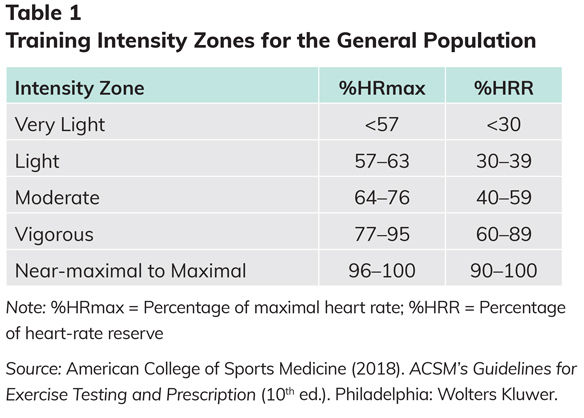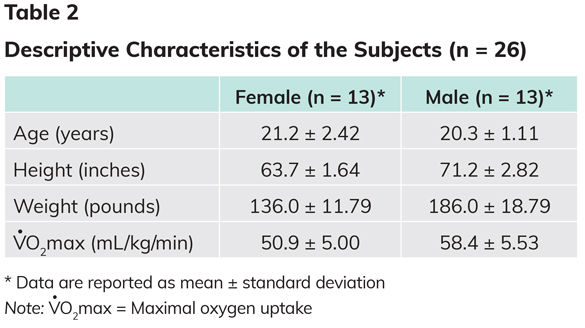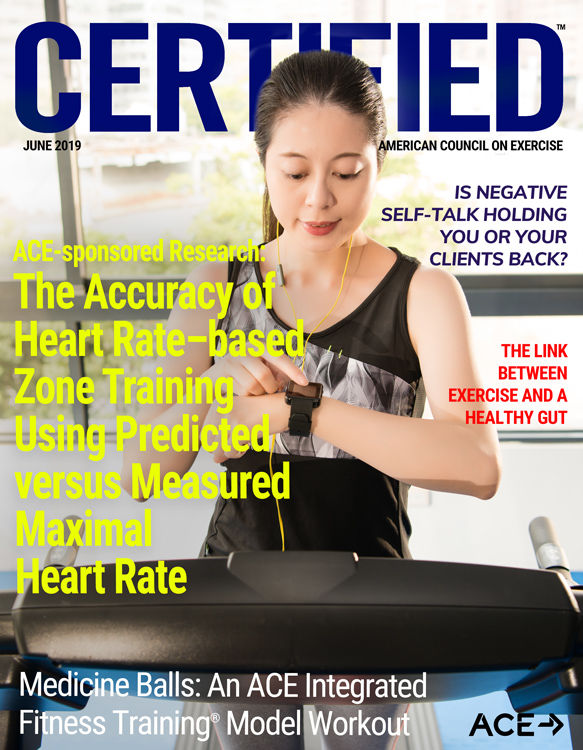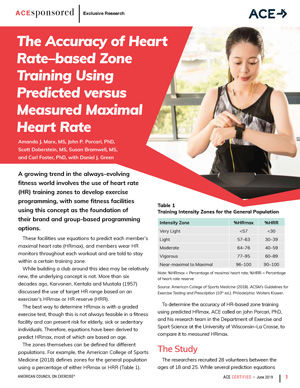
By Amanda J. Marx, MS, John P. Porcari, PhD, Scott Doberstein, MS, Susan Bramwell, MS, and Carl Foster, PhD, with Daniel J. Green
A growing trend in the always-evolving fitness world involves the use of heart rate (HR) training zones to develop exercise programming, with some fitness facilities using this concept as the foundation of their brand and group-based programming options. These facilities use equations to predict each member’s maximal heart rate (HRmax), and members wear HR monitors throughout each workout and are told to stay within a certain training zone.
While building a club around this idea may be relatively new, the underlying concept is not. More than six decades ago, Karvonen, Kentala and Mustala (1957) discussed the use of target HR range based on an exerciser’s HRmax or HR reserve (HRR).
The best way to determine HRmax is with a graded exercise test, though this is not always feasible in a fitness facility and can present risk for elderly, sick or sedentary individuals. Therefore, equations have been derived to predict HRmax, most of which are based on age.
The zones themselves can be defined for different populations. For example, the American College of Sports Medicine (2018) defines zones for the general population using a percentage of either HRmax or HRR (Table 1).

To determine the accuracy of HR-based zone training using predicted HRmax, ACE called on John Porcari, PhD, and his research team in the Department of Exercise and Sport Science at the University of Wisconsin–La Crosse, to compare it to measured HRmax.
The Study
The researchers recruited 28 volunteers between the ages of 18 and 25. While several prediction equations exist, the researchers chose to use an equation developed by Gellish and colleagues (2007), which has a standard deviation of ±5 to 8 beats per minute, to estimate each subject's HRmax:
Predicted HRmax = 207 – 0.7 (age)
From that prediction, target HRs were calculated that would place the subject in the middle of each of five training zones, which are based on training intensity zones for athletes as defined by Edwards (1992):
- Zone 1 = 50–59% HRmax
- Zone 2 = 60–69% HRmax
- Zone 3 = 70–79% HRmax
- Zone 4 = 80–89% HRmax
- Zone 5 = 90–100% HRmax
The subjects completed a 35-minute exercise bout on a motorized treadmill that was divided into seven five-minute segments, run consecutively. The training zones for the seven segments were as follows: 1, 3, 2, 4, 2, 5 and 2. During pilot testing, it was found that exercisers could not reasonably achieve zone 1 HRs after the warm-up period, which is why zone 1 is not included in the later stages.
To enable the subjects to achieve the target HR, the speed and grade of the treadmill were adjusted during each five-minute segment. Heart rate was monitored throughout the session and recorded at the 4:30 and 5:00 marks of each five-minute segment. These two HRs were then averaged to determine the exercise HR for each of the seven segments. Ratings of perceived exertion (RPE) were assessed at the end of each five-minute segment using the Borg (1973) 6 to 20 scale.
Each subject also completed an incremental maximal exercise test on the treadmill to determine actual HRmax and maximal oxygen uptake (VO2max). The test started at a self-selected walking or running speed on a treadmill at a 0% grade. The grade was increased by 2.5% every two minutes until the subject reached volitional fatigue. HRmax was defined as the highest HR observed at any point during the test and VO2max was defined as the highest continuous 30-second measurement of VO2 during the test.
The Results
Of the 28 subjects, 26 completed the study (Table 2). One was removed because of technical difficulties with the HR monitor and one because the subject did not achieve a respiratory exchange ratio >1.0 during the maximal exercise test, which indicates a less than maximal effort.

The average measured HRmax of the subjects was 192 ± 6.6 bpm, while the average predicted HRmax was 193 ± 1.3 bpm. There was no significant difference between these two values. In addition, it was found that 14 subjects (54%) had a measured HRmax greater than their predicted HRmax and 12 subjects (46%) saw the opposite result.
Collectively, exercise HR was collected 182 times (7 exercise segments x 26 subjects). Of those 182 times, subjects’ exercise HRs were in the correct zone based on their predicted HRmax 82% of the time (150/182). When measured HRs were above the targeted zone, HR was found to be off by an average of 4 ± 5.3 bpm. When measured HRs were below the targeted zone, HR was found to be off by an average of 6 ± 3.0 bpm.
The results suggest that even when HR-based training zones are determined based on predicted HRmax values versus measured HRmax values, subjects were in the correct zone the majority of the time (82%). When subjects’ exercise HRs fell outside the target zone, it was not off by a large amount and resulted in training being off by only one zone.
It is important to remember, however, that one of the limitations of zone-based training is that the range of heart rates needed to be within a particular zone is quite large. For example, for a 21-year-old subject, predicted HRmax using the Gellish equation would be 192 bpm. To exercise within zone 4 (80–89% of HRmax), this subject’s HR could range from 153 to 170 bpm. Remember, the goal was to have subjects’ HRs fall in the middle of each zone, in this case 162 bpm. This means that this subject would have to be off by ±9 bpm to be outside the target zone.
A potential problem with using a predicted HRmax for zone training is that because of the individual variation in HRmax, there is no way to truly know if an exerciser is working in the correct zone. If someone has a higher HRmax than is predicted by the equation, he or she will be exercising at an intensity that is lower than intended and will not achieve the desired benefits of training. This situation often leads to dissatisfaction in the programming and an increased possibility of dropout. This is far from ideal, but the opposite scenario is much more problematic. If a client has a lower HRmax than is predicted, he or she may have difficulty reaching the target zone and overexert themselves in an effort to reach a predetermined value.
“This could be an absolute catastrophe,” says Dr. Porcari, the lead researcher. “You couple this situation with the super-motivated clients who often use this type of training and you’re setting up the client for disaster.”
For this reason, Dr. Porcari recommends that health and exercise professionals who are using equations to predict HRmax for their clients do so in conjunction with the use of RPE. “The truth is,” says Dr. Porcari, “you have no idea of an individual’s actual maximal heart rate when using any equation and the risk of being wrong is just too important. Teaching clients to use RPE reduces the risk of someone pushing themselves too hard in order to reach a target heart rate.” In other words, you should teach your clients to listen to their bodies as they exercise, not just go all out in an effort to hit a particular target.
One final note: If you are using an equation to predict clients’ HRmax and develop exercise programming, be sure to choose an equation with a low standard deviation. For example, the ubiquitous “220 – age” equation (Fox, Naughton and Haskell, 1971) has a standard deviation of ±10 to 12 bpm, while the Gellish et al. (2007) equation used in this research has a standard deviation of ±5 to 8 bpm. While the simplicity of using the “220 – age” formula may be tempting, the difference in accuracy can have a meaningful impact on your clients’ response to exercise programming.
References
American College of Sports Medicine (2018). ACSM’s Guidelines for Exercise Testing and Prescription (10th ed.). Philadelphia: Wolters Kluwer.
Borg, G.A. (1973). Perceived exertion: A note on “history” and methods. Medicine and Science in Sports and Exercise, 5, 90-93.
Edwards, S. (1992). The Heart Rate Monitor Book. Port Washington, N.Y.: Polar CIC.
Fox III, S.M., Naughton, J.P. and Haskell, W.L. (1971). Physical activity and the prevention of coronary heart disease. Annals of Clinical Research, 3, 404-432.
Gellish, R.L. et al. (2007). Longitudinal modeling of the relationship between age and maximal heart rate. Medicine and Science in Sports and Exercise, 39, 5, 822-829.
Karvonen, M.J., Kentala, E. and Mustala, O. (1957). The effects of training on heart rate: A longitudinal study. Annales Medicinae Experimentalis et Biologiae Fenniae, 35, 3, 307-315.

 by
by 





